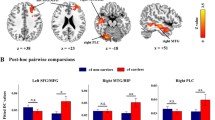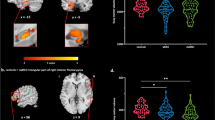Abstract
The ε4 allele of the APOE gene is thought to increase risk from amnestic mild cognitive impairment (aMCI) to Alzheimer’s disease. Cognitive decline in the condition is increasingly considered to worsen functional disconnections in brain network composed of gray matter and white matter. Nevertheless, Whether APOEε4 targets specific white matter functional connectivity in patients with aMCI remains mostly unexplored, mainly due to the challenges of detecting BOLD signals in white matter. Here, we applied a novel approach to investigate APOEε4-related specific bundles and cortical area alterations in aMCI subjects, in order to characterize white matter-gray matter functional connectivity differences throughout the brain. We analyzed 75 patients with aMCI and 76 demographically matched normal controls. The aMCI APOEε4 carriers showed decreased functional connectivity located at left corticospinal tract, bilateral posterior limb of internal capsule, and right temporopolaris, which was different from the regions of aMCI-related changes. We further found that recognition scores were positively associated with the right temporopolaris in aMCI APOEε4 carriers. Collectively, the data provide new evidence that APOEε4 genotype exerts a negative impact on neural activity in both gray and white matter in aMCI, which potentially contributes to functional disconnection and memory decline. A novel method provides full-scale measuring effect of disease conditions on functional architecture throughout the brain. Trial registration: https://www.ClinicalTrials.gov (Identifier: NCT02225964). Registered January 2014.





Similar content being viewed by others
References
Albert, M. S., DeKosky, S. T., Dickson, D., Dubois, B., Feldman, H. H., Fox, N. C., Gamst, A., Holtzman, D. M., Jagust, W. J., Petersen, R. C., Snyder, P. J., Carrillo, M. C., Thies, B., & Phelps, C. H. (2011). The diagnosis of mild cognitive impairment due to Alzheimer’s disease: recommendations from the National Institute on Aging-Alzheimer’s Association workgroups on diagnostic guidelines for Alzheimer’s disease. Alzheimer’s & Dementia, 7(3), 270–279.
Cacciaglia, R., Molinuevo, J. L., Falcon, C., Brugulat-Serrat, A., Sanchez-Benavides, G., Gramunt, N., Esteller, M., Moran, S., Minguillon, C., Fauria, K., Gispert, J. D. and A. study (2018). Effects of APOE-epsilon4 allele load on brain morphology in a cohort of middle-aged healthy individuals with enriched genetic risk for Alzheimer’s disease. Alzheimer’s & Dementia 14(7): 902–912.
De Simone, M. S., Perri, R., Fadda, L., Caltagirone, C., & Carlesimo, G. A. (2019). Predicting progression to Alzheimer’s disease in subjects with amnestic mild cognitive impairment using performance on recall and recognition tests. Journal of Neurology, 266(1), 102–111.
Ding, Z., Huang, Y., Bailey, S. K., Gao, Y., Cutting, L. E., Rogers, B. P., Newton, A. T., & Gore, J. C. (2018). Detection of synchronous brain activity in white matter tracts at rest and under functional loading. Proceedings of the National Academy of Sciences 115(3), 595–600.
Fan, J., Tao, W., Li, X., Li, H., Zhang, J., Wei, D., Chen, Y., & Zhang, Z. (2019). The Contribution of Genetic Factors to Cognitive Impairment and Dementia: Apolipoprotein E Gene, Gene Interactions, and Polygenic Risk. International Journal of Molecular Sciences, 20(5).
Fan, Y. S., Li, Z., Duan, X., **, 41(1), 230–240.
Farago, P., Toth, E., Kocsis, K., Kincses, B., Vereb, D., Kiraly, A., et al. (2019). Altered resting state functional activity and microstructure of the white matter in migraine with aura. Frontiers in Neurology, 10, 1039.
Gawryluk, J. R., Mazerolle, E. L., & D’Arcy, R. C. (2014). Does functional MRI detect activation in white matter? A review of emerging evidence, issues, and future directions. Frontiers in Neurology, 8, 239.
Gore, J. C., Li, M., Gao, Y., Wu, T. L., Schilling, K. G., Huang, Y., et al. (2019). Functional MRI and resting state connectivity in white matter - a mini-review. Magnetic Resonance Imaging, 63, 1–11.
Ji, G. J., Ren, C., Li, Y., Sun, J., Liu, T., Gao, Y., et al. (2019). Regional and network properties of white matter function in Parkinson’s disease. Human Brain Map**, 40(4), 1253–1263.
Jia, L., Quan, M., Fu, Y., Zhao, T., Li, Y., Wei, C., Tang, Y., Qin, Q., Wang, F., Qiao, Y., Shi, S., Wang, Y. J., Du, Y., Zhang, J., Zhang, J., Luo, B., Qu, Q., Zhou, C., Gauthier, S., Jia, J. & C. Group for the Project of Dementia Situation in (2019). Dementia in China: epidemiology, clinical management, and research advances. Lancet Neurology.
Jiang, Y., Song, L., Li, X., Zhang, Y., Chen, Y., Jiang, S., et al. (2019). Dysfunctional white-matter networks in medicated and unmedicated benign epilepsy with centrotemporal spikes. Human Brain Map**, 40(10), 3113–3124.
Kantarci, K., Murray, M. E., Schwarz, C. G., Reid, R. I., Przybelski, S. A., Lesnick, T., et al. (2017). White-matter integrity on DTI and the pathologic staging of Alzheimer’s disease. Neurobiology of Aging, 56, 172–179.
Kerchner, G. A., Berdnik, D., Shen, J. C., Bernstein, J. D., Fenesy, M. C., Deutsch, G. K., Wyss-Coray, T., & Rutt, B. K. (2014). APOE epsilon4 worsens hippocampal CA1 apical neuropil atrophy and episodic memory. Neurology, 82(8), 691–697.
Kljajevic, V., Meyer, P., Holzmann, C., Dyrba, M., Kasper, E., Bokde, A. L., Fellgiebel, A., Meindl, T., Hampel, H., Teipel, S. and E. s. group (2014). The epsilon4 genotype of apolipoprotein E and white matter integrity in Alzheimer’s disease. Alzheimers Dement, 10(3), 401–404.
Lee, S. H., Coutu, J. P., Wilkens, P., Yendiki, A., Rosas, H. D., Salat, H. D., & I. Alzheimer’s disease Neuroimaging. (2015). Tract-based analysis of white matter degeneration in Alzheimer’s disease. Neuroscience, 301, 79–89.
Li, J., Biswal, B. B., Wang, P., Duan, X., Cui, Q., Chen, H., & Liao, W. (2019a). Exploring the functional connectome in white matter. Human Brain Map**, 40(15), 4331–4344.
Li, M., Newton, A. T., Anderson, A. W., Ding, Z., & Gore, J. C. (2019b). Characterization of the hemodynamic response function in white matter tracts for event-related fMRI. Nature Communications, 10(1), 1140.
Li, X., Wang, X., Su, L., Hu, X., & Han, Y. (2019c). Sino Longitudinal Study on Cognitive Decline (SILCODE): protocol for a Chinese longitudinal observational study to develop risk prediction models of conversion to mild cognitive impairment in individuals with subjective cognitive decline. British Medical Journal Open, 9(7), e028188.
Liu, H., Yang, Y., **a, Y., Zhu, W., Leak, R. K., Wei, Z., et al. (2017). Aging of cerebral white matter. Ageing Research Reviews, 34, 64–76.
Liu, X., Hou, D., Lin, F., Luo, J., **e, J., Wang, Y., & Tian, Y. (2019). The role of neurovascular unit damage in the occurrence and development of Alzheimer’s disease. Reviews in the Neurosciences, 30(5), 477–484.
Lynall, M. E., Bassett, D. S., Kerwin, R., McKenna, P. J., Kitzbichler, M., Muller, U., & Bullmore, E. (2010). Functional connectivity and brain networks in schizophrenia. The Journal of Neuroscience, 30(28), 9477–9487.
Metzler-Baddeley, C., Hunt, S., Jones, D. K., Leemans, A., & Aggleton, J. P. and M. J. O’Sullivan (2012). Temporal association tracts and the breakdown of episodic memory in mild cognitive impairment. Neurology 79(23), 2233–2240.
Mori, S., Oishi, K., Jiang, H., Jiang, L., Li, X., Akhter, K., Hua, K., Faria, A. V., Mahmood, A., Woods, R., Toga, A. W., Pike, G. B., Neto, P. R., Evans, A., Zhang, J., Huang, H., Miller, M. I., van Zijl, P., & Mazziotta, J. (2008). Stereotaxic white matter atlas based on diffusion tensor imaging in an ICBM template. Neuroimage, 40(2), 570–582.
O’Donoghue, M. C., Murphy, S. E., Zamboni, G., Nobre, A. C., & Mackay, C. E. (2018). APOE genotype and cognition in healthy individuals at risk of Alzheimer’s disease: A review. Cortex; A journal devoted to the study of the nervous system and behavior, 104, 103–123.
Peer, M., Nitzan, M., Bick, A. S., Levin, N., & Arzy, S. (2017). Evidence for functional networks within the human brain’s white matter. The Journal of Neuroscience, 37(27), 6394–6407.
Pehrs, C., Zaki, J., Taruffi, L., Kuchinke, L., & Koelsch, S. (2018). Hippocampal-temporopolar connectivity contributes to episodic simulation during social cognition. Scientific Reports, 8(1), 9409.
Raichle, M. E., MacLeod, A. M., Snyder, A. Z., Powers, W. J., Gusnard, D. A., & Shulman, G. L. (2001). A default mode of brain function. Proceedings of the National Academy of Sciences of the United States of America, 98(2), 676–682.
Slot, R. E. R., Kester, M. I., Van Harten, A. C., Jongbloed, W., Bouwman, F. H., Teunissen, C. E., et al. (2019). ApoE and clusterin CSF levels influence associations between APOE genotype and changes in CSF tau, but not CSF Abeta42, levels in non-demented elderly. Neurobiology of Aging, 79, 101–109.
Smirni, D., Smirni, P., Di Martino, G., Fontana, M. L., Cipolotti, L., Oliveri, M., & Turriziani, P. (2019). Early detection of memory impairments in older adults: standardization of a short version of the verbal and nonverbal Recognition Memory Test. Neurological Sciences , 40(1), 97–103.
Sun, Y., Dai, Z., Li, Y., Sheng, C., Li, H., Wang, X., et al. (2016). Subjective cognitive decline: Map** functional and structural brain changes-a combined resting-state functional and structural MR imaging study. Radiology, 281(1), 185–192.
Suridjan, I., Pollock, B. G., Verhoeff, N. P., Voineskos, A. N., Chow, T., Rusjan, P. M., et al. (2015). In-vivo imaging of grey and white matter neuroinflammation in Alzheimer’s disease: a positron emission tomography study with a novel radioligand, [18F]-FEPPA. Molecular Psychiatry, 20(12), 1579–1587.
Veitch, D. P., Weiner, M. W., Aisen, P. S., Beckett, L. A., Cairns, N. J., Green, R. C., Harvey, D.,Jack, C. R. Jr., Jagust, W., Morris, J. C., Petersen, R. C., Saykin, A. J., Shaw, L. M., Toga, A. W.,Trojanowski, J. Q. & I.Alzheimer'sDiseaseNeuroimaging. (2019). Understanding disease progression and improving Alzheimer’s disease clinical trials: Recent highlights from the Alzheimer’s Disease Neuroimaging Initiative. Alzheimer’s & Dementia, 15(1), 106–152.
Wang, J., Yang, Z., Zhang, M., Shan, Y., Rong, D., Ma, Q., et al. (2019). Disrupted functional connectivity and activity in the white matter of the sensorimotor system in patients with pontine strokes. Journal of Magnetic Resonance Imaging, 49(2), 478–486.
Weiner, M. W., Veitch, D. P., Aisen, P. S., Beckett, L. A., Cairns, N. J., Green, R. C., et al. (2017). Recent publications from the Alzheimer’s Disease Neuroimaging Initiative: Reviewing progress toward improved AD clinical trials. Alzheimer’s & Dementia, 13(4), e1–e85.
Whitehair, D. C., Sherzai, A., Emond, J., Raman, R., Aisen, P. S., Petersen, R. C., et al. (2010). Influence of apolipoprotein E varepsilon4 on rates of cognitive and functional decline in mild cognitive impairment. Alzheimer’s & Dementia, 6(5), 412–419.
Yamazaki, Y., Zhao, N., Caulfield, T. R., Liu, C. C., & Bu, G. (2019). Apolipoprotein E and Alzheimer disease: pathobiology and targeting strategies. Nature Reviews Neurology, 15(9), 501–518.
Yan, C. G., Wang, X. D., Zuo, X. N., & Zang, Y. F. (2016). DPABI: data processing & analysis for (Resting-State) brain imaging. Neuroinformatics, 14(3), 339–351.
Yang, C., Zhang, W., Yao, L., Liu, N., Shah, C., Zeng, J., Yang, Z., Gong, Q., & Lui, S. (2019). Functional Alterations of White Matter in Chronic Never-Treated and Treated Schizophrenia Patients. Journal of Magnetic Resonance Imaging.
Zhao, J., Du, Y. H., Ding, X. T., Wang, X. H., & Men, G. Z. (2020). Alteration of functional connectivity in patients with Alzheimer’s disease revealed by resting-state functional magnetic resonance imaging. Neural Regeneration Research, 15(2), 285–292.
Acknowledgements
We thank the dedicated participants and staff of Xuanwu Hospital for data collection, including Yu Sun, **aoni Wang, Guanqun Chen, Weina Zhao, Bin Mu, Ziqi Wang, Yuxia Li, Ying Chen, Xuanyu Li, Wenying Du, Jiachen Li, **ng Zhao, Qin Yang, **aoqi Wang, Jun Wang, and Liu Yang.
Funding
This work was supported by The National Key Research and Development Program of China (2016YFC1306300, 2018YFC1312001), National Natural Science Foundation of China (Grant 61633018, 81871438).
Author information
Authors and Affiliations
Corresponding author
Ethics declarations
Conflict of interest and disclosure
No conflict of interest.
Additional information
Publisher's note
Springer Nature remains neutral with regard to jurisdictional claims in published maps and institutional affiliations.
Rights and permissions
About this article
Cite this article
Lin, H., Li, M., Zhan, Y. et al. Disrupted white matter functional connectivity in aMCI APOEε4 carriers: a resting-state study. Brain Imaging and Behavior 15, 1739–1747 (2021). https://doi.org/10.1007/s11682-020-00367-7
Published:
Issue Date:
DOI: https://doi.org/10.1007/s11682-020-00367-7




